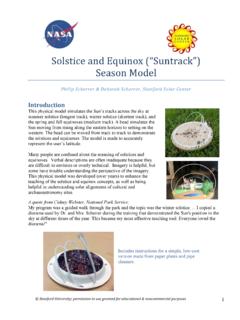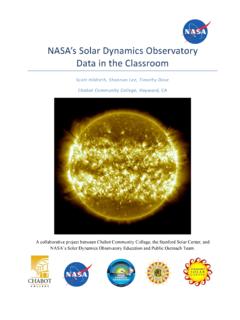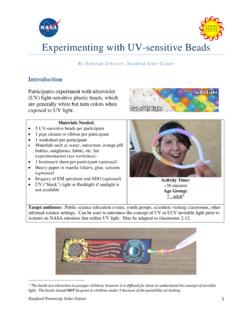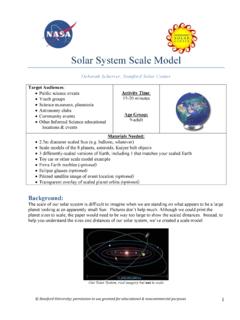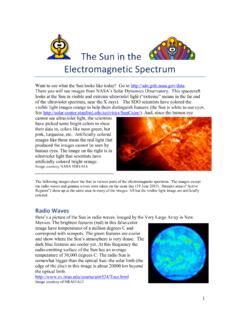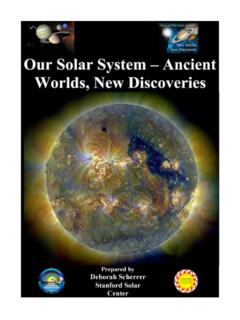Transcription of Teaching Moon Phases - Stanford University
1 Teaching moon Phases Deborah Scherrer Stanford University Solar Center Activity originally developed by Dennis Schatz, Pacific Science Center Age Range: Grades 4-14. Duration: 30-45 minutes Overview: This is an activity to teach and learn moon Phases and eclipses through hands-on modeling. It has three sections: 1. Understanding what causes moon Phases activity 2. Understanding what causes eclipses activity 3. Assessment/Firm-up ordering moon phase imagery activity This activity is inspired by one originally taught by Dennis Schatz to the Astronomical Society of the Pacific's Project Astro participants. The full activity is described in Astro Adventures, a publication of the Pacific Science Center. It is also available through the Astronomical Society of the Pacific shop, as part of their Universe at Your Fingertips DVD. It is highly recommended that users purchase one of these write-ups for doing a more extensive unit on moon Phases and eclipses: and Z3qlrvHAhVQKYgKHSDkBBM&url=https%3A%2F% content%2 Fuploads% Gqb_1F-qvHqt0jXCNdBpuR3uDoGA&sig2=EukJnL FQIgyZB-DRn27 UYA.
2 2015 Stanford University . Permission given to use for educational purposes. 1. Activity Goals: Participants will learn that: The moon is always half-lit by the Sun. moon Phases are caused by observing the half-lit moon at different times during its orbit of the Earth. All people on Earth see the same moon phase at the same time, though those in the southern hemisphere see the moon upside down compared with the northern. Solar eclipses are caused by the moon coming exactly between the Earth and the Sun, blocking all but a small shadow of the Sun's light to the Earth. Only a small number of people can observe a solar eclipse because of the small size of the shadow. Lunar eclipses are caused by the Earth coming directly between the Sun and the moon , casting a shadow on the moon . Everyone on the night-side of the Earth can observe a lunar eclipse. Solar and lunar eclipses do not occur every month because the moon 's orbit is tilted to the Earth's plane of orbit around the Sun.
3 So the moon , Earth, and Sun rarely line up exactly. Materials: Light source: A tall floor lamp with the shade taken off. Or, a light bulb on a stand or clip that can be placed about meters high. Clear incandescent light bulbs work best. Battery- powered lanterns sometimes work. Small ball: A white (or light-colored) ~5cm (2 ) ball for each participant. These could be made of Smoothfoam , Styrofoam , Model Magic , clay, paper mache, or they could be golf balls, tennis balls, wooden globes, round fruits, whatever. You may need to drill a hole in each ball for the holder to be inserted. Stick: 1 satay stick, pencil with a sharp point, wooden stick, etc. to serve as a holder. You'll need 1for each ball. (Avoid very sharp sticks when working with children.). 2. Signs (optional): A set of small West and East paper signs for each participant;. use tape or pins to attach these to their shoulders ( clothes over shoulders).
4 Stick-on name tags work well. Dark place: A room that can be darkened, large enough for participants to form a circle around the light bulb, about meters (5 feet) away from it. You may need to form 2 circles (and add another light bulb), depending upon the number of participants you have. If you absolutely cannot find a dark room, you can still do the activity by using small flashlights to light the model Moons. See Drive By Science Teaching moon Phases : Preparation: Mention that the scale is way off in this activity. Give an example of the real Earth-to- moon scale, show a picture of the Earth and moon to scale, or have a model of an Earth and moon to scale then mention how far away and how large the Sun would be on that scale. At this scale, the Sun would be about meters in diameter and km away. Lesson Plan: 1. Get Oriented a. Have participants pin or tape their East card on their left shoulder, and West card on their right shoulder.
5 When they turn, they should turn towards their left shoulders. b. Darken the room and gather participants around the light bulb, but do not pass out the moon balls yet. Tell participants that: The light bulb = Sun Their head = Earth Their nose = current location Their left ear/shoulder = east 3. Their right ear/shoulder = west The ball on a stick will eventually represent the moon (but don't pass out the balls yet). c. Ask participants to stand where it is noon , then midnight, sunrise, sunset. Remember, they should turn towards their left shoulders. When all participants get this right, have them Turn around fully = 1 day Walk around the Sun (counterclockwise) = 1 year Repeat the daily cycle to make sure they get it . d. Pass out the ball Moons. Tell participants that the ball models represent the Earth's moon . Ask them how long it takes for the moon to orbit the Earth [about 1 month ( moonth )].
6 2. moon Phases Activity a. Have participants hold up their Moons. b. Ask participants where the light on the moon comes from [the Sun]. c. Have them stand facing the Sun/lamp at noon with the moon between them/Earth and the Sun. What do they see? [New moon or No moon or a dark moon ] For now, ignore the fact that they are also viewing a solar eclipse. d. Have them stand at midnight, with the moon opposite the Sun. Make sure people hold their moon high enough for it to catch the light. What do they see? [Full moon ]. e. Go back to noon (New/No moon ) and move their moon a bit to the left. What do they see? [small, waxing crescent] On what side of the moon is the crescent? [right]. 4. f. Have participants continue moving their moon leftward to first quarter, waxing gibbous, full, waning gibbous, last quarter, and back to new. g. Give participants time to experiment with their Moons.
7 First Quarter Waxing Gibbous Full moon Waning Gibbous Last Quarter Waning Crescent h. Remind them that, all this time, their head/Earth is spinning through about ~29. day-night cycles during the time it takes for one month/moonth to go by. i. Point out that there are 2 points during the cycle when the moon is in a crescent phase (waxing and waning), a gibbous phase (waxing and waning), and a quarter phase (first and last quarter). Ask participants to verbalize what differentiates these [the sides of the moon which are light or dark; the light part is always pointing towards the Sun]. 3. Timing a. Explain to participants that, to determine rising and settings times, they will need to use their periphery vision to determine when the light bub appears over their left/east shoulder and when it sets beyond their right/west shoulder. b. Have participants figure out roughly what time of day the New moon rises.
8 [sunrise]. c. What time of day does the Full moon rise? [sunset]. 5. d. What time of day do first quarter and last quarter rise? [1st quarter=noon, last quarter=midnight). e. What percentage of time is the moon up during the day? [roughly half the time]. moon Phases Timing Day of Phase Rise (approximate) High in Sky Set (approx.). cycle (approx.). 0 New moon sunrise noon sunset Waxing crescent ~ 9 AM ~3 PM ~9 PM. First Quarter noon sunset midnight 11 Waxing gibbous ~3 PM ~9 PM ~3 AM. Full moon sunset midnight sunrise Waning gibbous ~9 PM ~3 AM ~9 AM. 22 Last Quarter midnight sunrise Noon Waning crescent ~3 AM ~9 AM ~3 PM. New moon sunrise noon sunset 4. General a. Ask them if all people on Earth see the same phase of the moon on any given day? [yes]. b. Do the people in the southern hemisphere see the same phase of the moon as in the northern hemisphere [yes, except that it is upside down].]
9 Image credit: emisphere/. 6. 5. Eclipses a. Have participants model a solar eclipse by placing the moon , at noon, between the Earth & Sun. In what phase is the moon ? [new] [this is also how they observed the New moon ]. b. Model a lunar eclipse by placing the Earth between the moon and Sun at midnight. This time, they should lower their moon ball to fall into the Earth's shadow. In what phase is the moon ? [full]. c. How many people on Earth can see a total solar eclipse? Go back to the solar eclipse arrangement and refer to the small shadow that falls on people's faces when they are modeling a solar eclipse. [Only a few people on Earth fall into that shadow, so only a few can see the total solar eclipse.]. d. Go back to the total lunar eclipse. How many people can see a total lunar eclipse? [everyone on the night side, because the shadow covers the entire moon ]. e. Why don't we have solar eclipses and lunar eclipses every month?
10 [the moon 's orbit is tilted so it rarely falls exactly in line with the Sun]. f. If you wish, show participants an image of a total solar eclipse (one is attached). During a solar eclipse, what color is the corona? [white]. Hence what color is the Sun? [white see http://solar- ]. Credit: NASA/Cirtain g. If you wish, show participants an image of a total lunar eclipse (one is attached). During a lunar eclipse, the moon is often reddish. Ask your participants if they know why. [light is scattered through the Earth's atmosphere and only the long red & orange waves get through to illuminate the moon see ]. Credit: Heribert Propepper / Associated Press File 7. 6. Firming up the Information (could also be used for assessment) by Ordering moon Phase Imagery a. Divide participants into pairs. b. Copy a sheet of the Ordering moon Phases imagery (attached). for each pair. Either cut out the images beforehand, or have participants cut them out.
